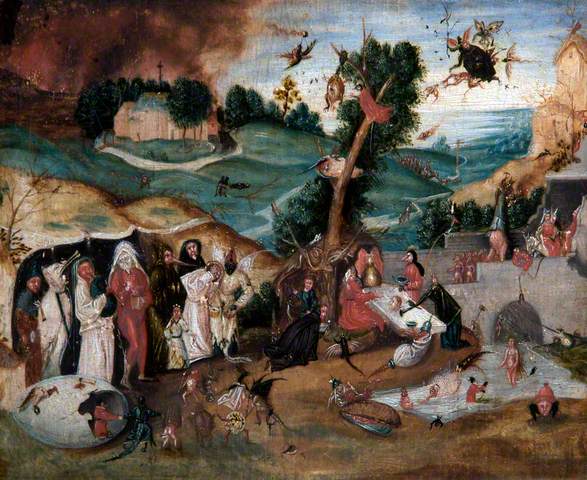The obscurity of irrational laws. Among Hieronymous Bosch’s several known followers, or “school of” painters was Pieter Huys. Although his pictorial concoctions do not approach those of the master in hellish power and impact his Temptation of Saint Anthony does have a dreamlike quality, a search for security and purpose without pious horror within a context of syncopated realism.
The Temptation of Saint Anthony was a rich subject for the painters of diableries; Bosch himself did a picture of this hermit saint, a fragile enigma not unaware that his own appetites are as sharp as a fox’s, whether engendered by loneliness or a ready heart is never clear. Anthony’s mind was a battleground between a yearning to achieve grace through prayer in confrontation with evil thoughts that possessed him despite the vague concern that neuroses are not that plausible in ostensibly holy men and our sympathy can waver knowing that in a lusty leap Anthony could be a stand-in role from a Marquis de Sade epic. It can question the insipidity of a suffering humanity when that is perceived as needless when defiant egos are at cross purposes.

—
Anthony the Great, Christian saint and hermit, is shown twice on this one panel. He spent a lot of his life in the Egyptian desert and suffered hallucinations. He is first seen being visited by disguised demons under a tree, and then when tormented by others in the air.
Ultimately, this painting derives from the various treatments of this temptation theme by Hieronymus Bosch (c.1450–1516), but it is a less disturbing imitation.—click image for source…
Huys shows the saint within a crowded nightmarescape centering around the lovely figure of a nude girl but flowering all round into evil forms. Very real misery enhanced by a certain virtuosity in ringing changes on the theme. Here, there are numerous hideous inventions which torment the holy man such as the girl holding a small owl and a hag crouching with a distaff and beside her a female monster with a platter upon which she offers what appears to be a piece of carrion.
Huys’s agonized complications are a reflection of the man that produced it and an expression of the time and place that produced it. The contrast here lies between the premise that characterizes Italian painting, that in spite of evil the world ultimately is good and beautiful, a succumbing eventually to divine order as opposed to Northern pessimism, chaotic, tragic, malevolent and with little saving grace save for some shards of the mysterious which on the whole leads itself to a certain foundation establishing a cult of death as viable narrative.







 COMMENTS
COMMENTS